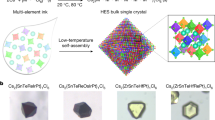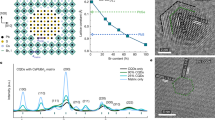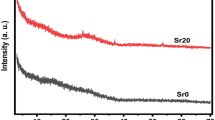Abstract
POLYSILANES are used as resists in microlithography and as precursors for silicon carbide ceramics1–3. We have been investigating the formation of polysilanes by the reductive dechlorination polymerization of dichloro-organosilanes with sodium4—a modification of the well-known Wurtz reaction, in which organic halides are reductively coupled using sodium to form carbon-carbon single bonds. In all such reactions, after a period of time a blue precipitate is formed, but no characterization of this solid has so far been reported. It has been suggested (without spectroscopic evidence) that the colour in the polysilane synthesis is due to defects in sodium chloride1, sodium colour centres in sodium chloride3,5, reactive polysilane chain-ends3 or a stabilized organic radical6. The first of these suggestions has been tacitly accepted despite the fact that the most common defects in sodium chloride are F centres (anion vacancies with trapped electrons from excess sodium atoms) which give the salt a yellow colour7,8. Here we present spectroscopic results suggesting that the blue colour is due to colloidal alkali-metal particles formed during the reaction. These particles are contained in a matrix composed of an intimate mixture of polymer and alkali-metal halide, and are remarkably stable in air. It is most unusual for colloidal metal particles to be formed under such mild conditions.
This is a preview of subscription content, access via your institution
Access options
Subscribe to this journal
Receive 51 print issues and online access
$199.00 per year
only $3.90 per issue
Buy this article
- Purchase on Springer Link
- Instant access to full article PDF
Prices may be subject to local taxes which are calculated during checkout
Similar content being viewed by others
References
Michl, J. & Miller, R. D. Chem. Rev. 89, 1359–1410 (1989).
West, R. J. organomet. Chem., 300, 327–346 (1986).
Worsfold, D. G. in Inorganic and Organometallic Polymers. ACS Symp. Ser. 360 (eds Allcock, H. R., Wynne, K. J. & Zeldin, M.) 101–111 (American Chemical Society, Washington DC, 1988).
Cragg, R. H., Jones, R. G., Swain, A. C. & Webb, S. J. J. chem. Soc. Chem. Commun 1147–1148 (1990).
Hengge, E. & Reuter, H. Naturwissenschaften, 42, 514 (1962).
Burkhard, C. A. J. Am. chem. Soc. 71, 963–964 (1949).
Compton, W. D. & Schulman, J. H. Color Centers in Solids, 29; 52–53 (MacMillan, New York, 1962).
Doyle, W. T. Phys. Rev. 111, 1067–1072 (1958).
Wurtz, A. Justus Liebigs Ann. Chem. 96, 364–375 (1855).
March, J. Advanced Organic Chemistry. Reactions, Mechanism, and Structure, 2nd edn, 407–412 (McGraw Hill, London 1977).
Hughes, A. E. & Jain, S. C. Adv. Phys. 28, 717–828 (1979).
Vitol, A. Ya., Kharakhash'yan, E. G., Cherkasov, F. G. & Shvarts, K. K. Fizika Tverd. Tela 13, 2133–2135 (1971); (Engl. transl.) Sov. Phys. Solid St. 13, 1787–1789 (1972).
Gordon, D. A. Phys. Rev. B13, 3738–3747 (1976).
McMillan, R. C. J. Phys. Chem. Solids 25, 773–775 (1964).
Guy, S. C., Edmonds, R. N. & Edwards, P. P. J. chem. Soc. Faraday II, 81, 937–947 (1985).
Feher, G. & Kip, A. F. Phys. Rev. 98, 337–348 (1955).
Seidel, H. & Wolf, H. C. in Physics of Color Centres (ed. Fowler, W. B.) 555 (Academic, New York/London, 1968).
Karatsu, T. et al. J. Am. chem. Soc. 113, 2003–2010 (1991).
Zeigler, J. N., Harrah, L. A. & Johnson, A. W. Polymer Preprints 28, 424–425 (1987).
Trefonas, P. & West, R. Inorg. Synth. 25, 56–60 (1989).
Smithard, M. A. & Tran, M. Q. Helv. Phys. Acta 46, 869–888 (1974).
Doyle, W. T. Proc. Phys. Soc. 75, 649–663 (1960).
Radchenko, I. S. Optik. Spektrosk. 25, 899–902 (1968); (Engl. trans.) Opt. Spectrosc. 25, 500–501 (1968).
Scott, A. B., Smith, W. A. & Thompson, M. A. J. phys. Chem. 57, 757–761 (1953).
Aso, J., Baba, M. & Ikeda, T. Jap. J. appl. Phys. 29, 308–312 (1990).
Kleinschrod, F. G. Ann. Phys. 27, 97–107 (1936).
Author information
Authors and Affiliations
Rights and permissions
About this article
Cite this article
Benfield, R., Cragg, R., Jones, R. et al. Air-stable alkali-metal colloids and the blue colour in Wurtz syntheses. Nature 353, 340–341 (1991). https://doi.org/10.1038/353340a0
Received:
Accepted:
Issue Date:
DOI: https://doi.org/10.1038/353340a0
This article is cited by
-
Engineering a material for biomedical applications with electric field assisted processing
Applied Physics A (2009)
-
Low-energy synthesis of air-stable alkali metal colloids in a polymer/alkali halide matrix
Zeitschrift f�r Physik D Atoms, Molecules and Clusters (1993)
Comments
By submitting a comment you agree to abide by our Terms and Community Guidelines. If you find something abusive or that does not comply with our terms or guidelines please flag it as inappropriate.



